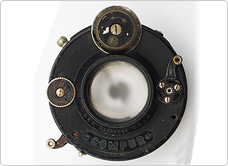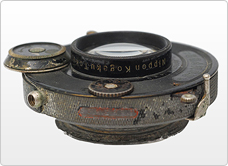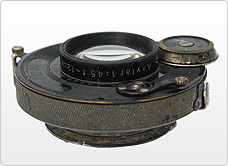
Heinrich Acht
Looking back over the history of the development of Nikon photographic lenses, design work began in earnest in 1921 by engineers invited to Japan from Germany. Nikon started out by attempting to imitate the designs of the major types of lens of the day—the Triplet, the Tessor and the Dagor—as a means of catching up with the level of optical engineering in the advanced nations. A series of lenses with designs modeled on the Zeiss Tessor were named "Anytar" lenses. In charge of the design of the Anytar lenses was Heinrich Acht, a German engineer who headed the design division's mathematics department and is reputed to have been involved in the design of virtually all the Anytar lenses. It is known that seven types of Anytar lens were designed—these having focal lengths of 7.5 cm, 10.5 cm, 10.7 cm, 12 cm, 15 cm, 18 cm and 36 cm.
Mr. Yoshihashi's notebook

Cover of Yoshihashi's notebook
A notebook left behind by one of the engineers, Kagoro Yoshihashi, has been preserved in the Nikon historical archives. This notebook, entitled "Photographic Lenses, May 1930," contains records of 27 different types of lens, including the Triplet, the Tessor and the Dagor. These records include data on four Anytar lenses, with focal lengths of 10.5 cm, 10.7 cm, 15 cm and 18 cm—all of aperture f/4.5. According to the Yoshihashi notebook, the 10.7 cm Anytar lens was designed by Mr. Dillmann, another German engineer, while the 10.5 cm Anytar lens was designed by Mr. Yoshihashi himself.
The 10.5 cm f/4.5 Anytar lens was initially designed by Mr. Acht; however, in 1928, Mr. Yoshihashi made improvements to the design, based on the data for the original lens. An optical diagram and a lens aberration diagram from Mr. Yoshihashi's notebook are shown for the reader's interest.

Optical diagram of 10.5 cm f/4.5 Anytar lens
Anytar lens improvements
After Mr. Acht's return to Germany in 1928, engineers led by Kakuya Sunayama, the head of the design division, made full use of the German design methodology to make improvements to the lens designs, based on the design data left behind by Mr. Acht. After completion of the prototype of the Anytar 12 cm f/4.5 at the end of 1929, further modifications were made, such that by 1931 it was said to compare favorably with the Zeiss Tessor. There is no record of how many of these lenses were manufactured, however.
There are two examples of Anytar lenses in the Nikon historical archives: a 10.7 cm f/4.5 model and a 12 cm f/4.5 model, both with a built-in Compur shutter. The 10.7 cm f/4.5 model was a prototype, while the 12 cm f/4.5 model was a commercial product and was engraved with the inscription "Anytar" and "Nippon Kogaku Tokyo". The 12 cm f/4.5 lens was donated to the Nikon historical archives by Yutaka Sugi (the former president of Nippon Kogaku Kogyo; he passed away in 1981), and with the shutter and aperture still in working order, it can still even now be used to shoot pictures.

10.7 cm f/4.5 (left) and 12 cm f/4.5 Anytar lenses

Front of 10.7 cm f/4.5 Anytar lens

Front of 12 cm f/4.5 Anytar lens
The Anytar 12 cm f/4.5 lens was evidently made available to company employees around 1937 at a discount price of 20 yen. (According to the corporate price index released by the Bank of Japan, however, 20 yen in those days was equivalent to 12,000 yen in 2008 in terms of purchasing power.) Further improvements were made to the Anytar 12 cm f/4.5 lens and this led to the development of the Nikkor 12 cm f/4.5, which was the genesis for the successive production of the Tessor-type Nikkor 7.5 cm, 10.5 cm and 18 cm lenses. As the forerunner of the Nikkor lens series, the Anytar is certainly a lens of historical significance.





